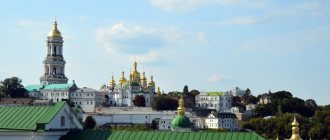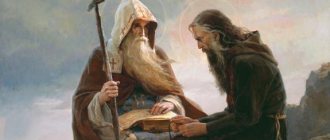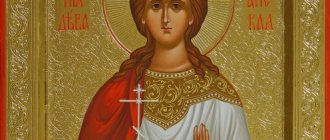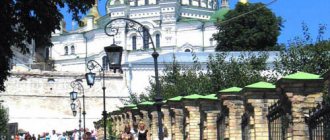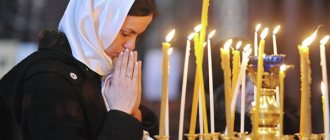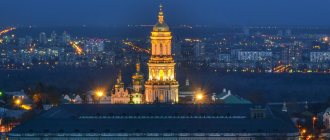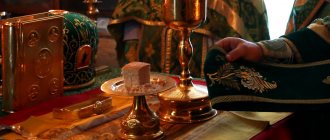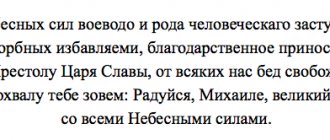Saints of Kiev-Pechersk
Council of All Reverend Fathers of the Kiev Pechersk (common memory on the 2nd Sunday of Great Lent)
The Kiev Pechersk Lavra gave birth to many devotees of piety who shone in the church horizon like stars. These reverend fathers, shining with their virtues and miracles, “are worthy,” as the Monk Polycarp, Archimandrite of Pechersk, wrote, “to remain in heaven as heirs of angelic glory. They lived an angelic life on earth, not caring about the flesh here, but as disembodied, they treated earthly things with disdain and considered everything worldly to be rubbish. Seeking Christ alone in their lives, they loved Him and became attached to Him with love and betrayed and submitted their will to Him in order to receive deification from Him. He, in reward for their labors and exploits, granted them retribution even on earth - the gifts of miracles, and in heaven he glorified them with indescribable glory.”
The Lord glorified the Kiev-Pechersk fathers, who accepted a selfless feat in order to inherit the Kingdom of Heaven, with many miracles. And the Holy Church, giving them praise, pleases and glorifies them, celebrating each of them on the days of their memory. However, the memory of all the venerable fathers who rest in the Lavra caves - those who are known to church history, and those who remained known only to one God - the Church triumphs together on one day, which is called the Council of All Saints of the Kiev-Pechersk.
Tree of Kiev-Pechersk Saints
The holy Kiev-Pechersk fathers asceticised and departed to eternal abodes, and their incorruptible relics, filled with grace, still rest in caves, some of which are called Near, or Antoniev, and others - Far, or Feodosiev. Accordingly, there are also two other days of conciliar veneration of the Kiev-Pechersk saints - the Council of the Saints of the Kiev-Pechersk, resting in the Near Caves, and the Synaxis of the Saints of the Kiev-Pechersk, resting in the Far Caves.
Troparion to the Council of the Reverend Fathers of the Kiev Caves, tone 2
When you are buried in the graves and imprisoned yourself, then, having mortified the carnal passions, you buried Christ, God-bearing, and the devil in the underground, destroying the fence, for this sake the Angels give you crowns from heaven.
Kontakion, tone 8
Fathers of all honor, God-red face, sources of many miracles, flowing myrrh, the red-rich treasures of the Lord, hidden in the earth, do not stop, we pray, praying to the Lord for us, and we call to you: Rejoice, lamps of the whole world.
Prayer
Our reverend and God-bearing fathers Anthony and Theodosius and all the reverend Pecherstia, the bright earthly luminary, shining gloriously from the dark places of the caves into the Russian land, and with many luminous angels equal to your life, the stars of your life enraged, and surprised the entire universe of high virtues with the lordships and miracles of the Divine. And now, the mortal West has carnally entered the grave for a while, souls with Christ, the Sun of righteousness, being a righteous woman, are enlightened like the sun in the Kingdom of Heaven. Wherever your prayers to God the Light extend rays for your fatherland, do not forget us, your everlasting prayer books, abiding in the nights of passions and sorrows, looking upon the radiance with grace from above. Because in the light of your virtuous life we walk the right way, let us be worthy to see the light of the inviolable glory of God, praising Him together with you for endless ages. Amen.
PORTAL CONTACTS
Location of the shrine (altar, temple, chapel, etc.):They stay in the St. Alexievsky Convent of Saratov in the church in honor of the Icon of the Most Holy Theotokos “Hodegetria” of Smolensk.
Description:
Icon “Cathedral of the Kiev-Pechersk Elders”. The size of the icon is 70x50 cm.
Reliquary containing 83 pieces of relics of saints.
Far Caves (St. Theodosius)
1. Smuch. Vladimir Metropolitan of Kiev 2. St. Philaret Metropolitan of Kiev 3. St. Pavel Metropolitan of Tobolsk 4. Rev. Theophilus Bishop of Novgorod 5. Rev. Ignatius Archimandrite of Pechersk 6. Rev. Lucian the Hieromartyr. 7. Rev. Martyrius Deacon 8. Rev. Macarius Deacon 9. Rev. Akhila Deacon 10. Rev. Agathon the Wonderworker 11. Rev. Moses the Wonderworker 12. Rev. Gregory the Wonderworker 13. Rev. Euthymius the schema-monk 14. St. Hilarion the schema-monk 15. Rev. Silouan the schema-monk 16. Rev. Sisoi schema-monk 17. Rev. Theodore Prince of Ostrog 18. St. Youth Gerontius, Canonarch of Pechersk 19. St. Youth Leonty, Canonarch of Pechersk 20. Rev. Zinon the faster 21. Rev. Mercury fasting 22. Rev. Zechariah the faster 23. Rev. Pimen the faster 24. Rev. Lavrenty the recluse 25. Rev. Arseny the hardworking 26. Rev. Joseph the sickly 27. Rev. Paul the obedient 28. Rev. Nestor the unbook 29. Rev. Theodore the silent 30. Rev. Hypatius the healer 31. Rev. Longinus goalkeeper 32. Rev. Titus the warrior 33. Rev. Benjamin 34. Rev. Paisiy
Nearby Caves (St. Anthony)
1. Rev. Simon Bishop of Suzdal 2. Rev. Ephraim Bishop Pereyaslavsky and Khmelnitsky 3. Rev. Niphon Bishop of Novgorod 4. Rev. Lawrence Bishop of Turov 5. Rev. Polycarp Archimandrite 6. Rev. Varlaam abbot 7. Rev. Nikon Abbot of Pechersk 8. Rev. Titus Hieromonk 9. Rev. Nicodemus prosphora book 10. Rev. Spiridon prosphora 11. Rev. Martyr Anastasius Deacon 12. Rev. Kuksha Hieromartyr 13. Rev. Nectarius the schema-monk 14. Rev. Eustratius the Martyr 15. Rev. Theodore the Martyr (brothers) 16. Rev. Basil the Martyr (brothers) 17. St. Martyr. John the Child 18. Rev. Alypius icon painter 19. Rev. Gregory the icon painter 20. Rev. Nestor the Chronicler 21. Rev. Gregory the Wonderworker 22. Rev. Agapit, free doctor 23. Rev. Damian the healer 24. Rev. John the long-suffering 25. Rev. Pimen the many-sick 26. Rev. Theophan the faster 27. Rev. Pimen the faster 28. Rev. John the Faster 29. Rev. Athanasius the recluse 30. Rev. Isaac the Recluse 31. Rev. Onesiphorus the Confessor 32. Rev. Savva the God-pleaser 33. Rev. Nikon dry 34. Rev. Onuphry the silent 35. Rev. Sergius the obedient 36. Rev. Prokhor Lobodnik 37. Rev. Saint Nicholas 38. St. Abraham the hardworking 39. Rev. Marco the grave digger 40. Rev. Luke Economist Pechersky 41. Rev. Moses Ugrin 42. Rev. Ilya Muromets 43. Rev. Macarius 44. Rev. Sylvester 45. Rev. Anatoly 46. Rev. Isaiah 47. Rev. Erasmus 48. Rev. John 49. Rev. Theophilus
Authenticity (including history of appearance in the temple/monastery):
Particles of the relics were transferred by Bishop Irinei of Nizhyn and Prilutsk at the request of the monastery sisters in 2011. The icon was painted in the workshop of the Shchigry brotherhood and purchased in 2010.
Personality of the saint
Agapit was loving, but at the same time strict and did not look at faces. He treated both the poor and the rich equally, without leaving the walls of the monastery. I have never left the walls of the Lavra since I became a monk. Even when Prince Vladimir Monomakh fell ill and asked him to come to him, the saint refused to break the monastic rules. Agapit said that it was not right for a monk to go around people and do healing.
Icon of Saint Agapit of Pechersk
I took greens, dill or parsley from my meal, what all the monks ate. And he sent some of this blessed food to the Grand Duke so that he could be healed. And so it happened. The grateful prince then himself came to the monastery to thank the monk, but he, out of his characteristic humility, hid to avoid honors.
Agapit did not take bribes for healing. He was unmercenary, like the Lord, who said to the apostles: “Freely you have received, freely give,” that is, do good to people, but do not take money for it. By the way, setting a price for healing, for an expected miracle, which various healers often promise, is a principle of anti-Christianity, a sign of false apostleship.
A true servant of God, who has received a gift from above, does not set a price for his services and good deeds. People can thank him according to their zeal, but he wants to accept it or not. This is his will, but setting a price for this or that holy cause is a false Christian, unhumble thing.
Interesting! In Soviet times, the relics of St. Agapit were studied. On his fingers, even to this day, pollen from medicinal plants that he collected in the Kyiv hills near the Dnieper has been preserved. On the icons the saint is depicted with a bunch of herbs, with a decoction of which, and of course, prayer, he healed people.
Life of Saint Agapit
The Monk Agapit, the unpaid doctor of Pechersk, was one of the first to come to the monastery. He himself was from Kyiv, born and died in the 11th century. Nothing is known about life before coming to the monastery. He took monastic vows during the reign of St. Anthony of Pechersk. People called St. Agapit a doctor. The saint compassionately looked after the sick, prayed for them with love, and the Lord, through his prayer, healed people. And when the monk saw this, he realized that people could glorify him.
Venerable Agapit of Pechersk
In order to get rid of vain human glory, that is, vanity, he began to hide his gift of healing by simply treating the sick with his food. People ate the usual boiled potion, and when they were healed, they thought that they had become healthy from a potion that the monk had specially prepared. That’s why Agapit of Pechersk was called a doctor.
At that time, there lived a doctor in Kyiv, an Armenian who was engaged in healing practice. But if he could not help a person, he accurately named the day of his death, never making a mistake - he had the rare gift of determining by pulse. When Vladimir Monomakh fell ill, he could not cure him, but predicted that he had three days to live. Then the sick man turned to Agapit, and the saint begged God for the Grand Duke to live longer.
The Armenian, taking the incident as a personal insult to himself, decided to poison Agapit. He sent people to the saint, who gave him poison to drink. He took the deadly cup from his hands. The killers waited, but the monk still did not die. The words of the Lord came true: “Whoever believes in me, even if he drinks something mortal, it will not harm him.”
Only in old age did Agapit fall ill, the monks decided to help and called a doctor. By God's providence the doctor turned out to be the same Armenian. He went into the cell, looked and said to Agapit of Pechersk: “Your face is distorted, you are no longer a tenant.” He took him by the hand and said that he would only live for three days. Agapit replied: “Yes, I know the day of my death, I will live another three months.” He laughed and said: “If you live more than three days, I will become a monk here in the Lavra.”
Three months passed, Agapit died, and the Armenian came to the abbot to ask to enter the monastery. He says: “I was not going to fulfill my rash promise, but Agapit appeared to me and warned me that if I break my oath, I will die.” And here he accepts Orthodoxy, takes monastic vows, strives for God, and eventually ends the days of his earthly life in the Lavra. So Agapit appeared to his enemy to save him. The Lord does not want the sinner to die, but for him to turn and live.
Miracles and help of the saint
To this day, people come to the saint, pray and receive help. And on the day of remembrance of the saint, an endless stream of people comes to give thanks for healing from incurable diseases.
A great many healings occur through the prayers of Agapit of Pechersk. There are no records of such cases; no one writes them down. But it happens that even during an ordinary meeting with a person in the Kiev Pechersk Lavra, you can learn about another miracle.
Hagiographic icon of the Venerable Doctor Agapit
One day, an elderly man told the monks what had happened. He was threatened with amputation of his arm, which he really did not want to part with. The man came to the Lavra and begged the monk for salvation. When a doctor examined him a few days later, he was very surprised to discover that his hand was healed. I began to ask the former patient by what means he managed to do this. When the elderly man said that the miracle of healing happened through the prayers of St. Agapit, the doctor believed and went into the cave to venerate the saint himself.
You can contact St. Agapit not only with requests for healing. He also helps with other everyday needs. But most often he still fulfills requests for the healing of illnesses.
How to ask a saint for help? When venerating a shrine with relics or an icon, you need to say: “Pray to God for us, Venerable Father Agapit of Pechersk,” or do it in your own words, which come from the depths of your soul.
Important! The Monk Agapit is revered along with other healers, such famous ones as, for example, St. Panteleimon.
The holy healer from the Kiev Pechersk Lavra is known all over the world, even in Alaska. Nowadays, miracles through the prayers of the saint do not stop; they are difficult to count; we do not know about many of them. In the caves of the Kiev Pechersk Lavra to St. Millions of people come to Agapit and other saints.
At one time, Bill Clinton also visited here several times, and prayed for a long time at the relics of St. Agapit and others. He said that on his first visit he received healing and since then has been trying to visit the monastery again and again. Other famous personalities have also visited here: V. Putin, D. Medvedev, many heads of European states.
